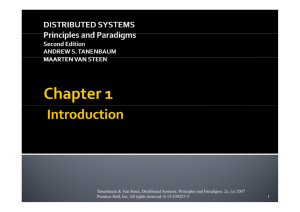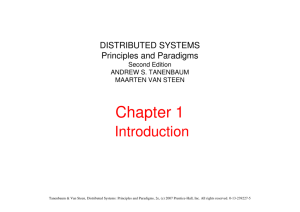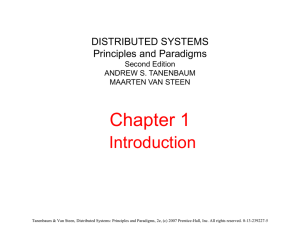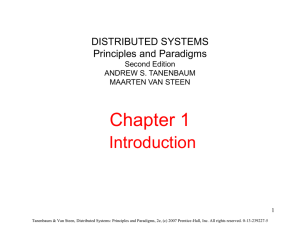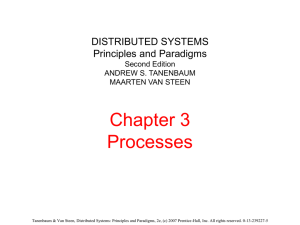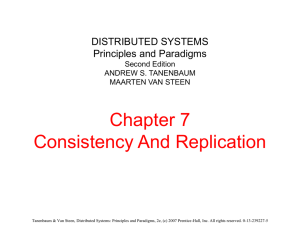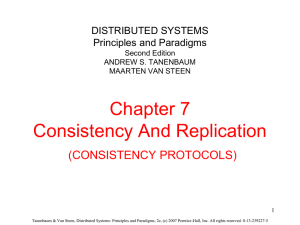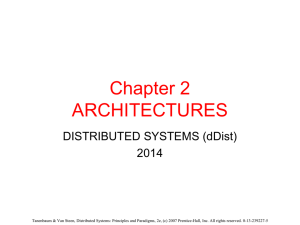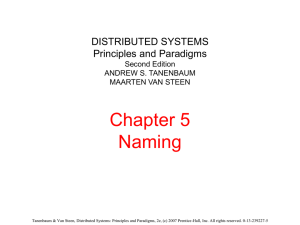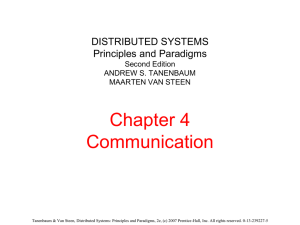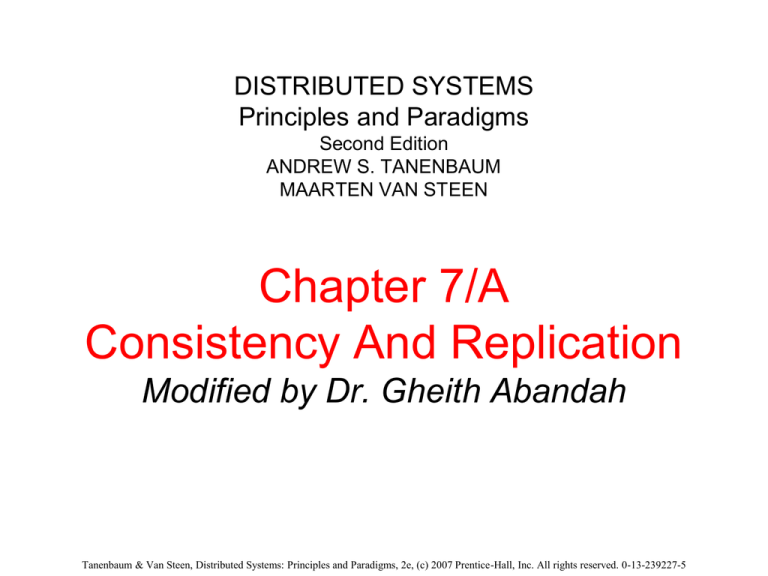
DISTRIBUTED SYSTEMS
Principles and Paradigms
Second Edition
ANDREW S. TANENBAUM
MAARTEN VAN STEEN
Chapter 7/A
Consistency And Replication
Modified by Dr. Gheith Abandah
Tanenbaum & Van Steen, Distributed Systems: Principles and Paradigms, 2e, (c) 2007 Prentice-Hall, Inc. All rights reserved. 0-13-239227-5
Overview
•
•
Reasons for Replication
Data-centric Consistency Models
•
•
•
Continuous Consistency
Consistent Ordering of Operations
Client-centric Consistency Models
•
•
•
•
•
•
Eventual Consistency
Monotonic Reads
Monotonic Writes
Read Your Writes
Writes Follow Reads
Replica Management
•
•
•
•
Replica-Server Placement
Content Replication and Placement
Content Distribution
Consistency Protocols
•
•
•
•
•
Continuous Consistency
Primary-Based Protocols
Replicated-Write Protocols
Cache-Coherence Protocols
Implementing Client-Centric Consistency
Tanenbaum & Van Steen, Distributed Systems: Principles and Paradigms, 2e, (c) 2007 Prentice-Hall, Inc. All rights reserved. 0-13-239227-5
Reasons for Replication
•
Data are replicated to increase the
reliability of a system.
Replication for performance
•
Scaling in numbers
Scaling in geographical area
Caveat
Gain in performance
Cost of increased bandwidth for
maintaining replication
Tanenbaum & Van Steen, Distributed Systems: Principles and Paradigms, 2e, (c) 2007 Prentice-Hall, Inc. All rights reserved. 0-13-239227-5
Data-centric Consistency Models
Consistency model: A contract between a (distributed) data store and
processes, in which the data store specifies precisely what the
results of read and write operations are in the presence of
concurrency.
The general organization of a logical data store, physically distributed
and replicated across multiple processes.
Tanenbaum & Van Steen, Distributed Systems: Principles and Paradigms, 2e, (c) 2007 Prentice-Hall, Inc. All rights reserved. 0-13-239227-5
Continuous Consistency (1)
Continuous consistency is often implemented as a toolkit
giving choice to the programmer.
Observation
We can actually talk a about a degree of consistency:
•
replicas may differ in their numerical value
•
replicas may differ in their relative staleness
•
there may be differences with respect to (number
and order) of performed update operations
Conit
Consistency unit → specifies the data unit over which
consistency is to be measured.
Tanenbaum & Van Steen, Distributed Systems: Principles and Paradigms, 2e, (c) 2007 Prentice-Hall, Inc. All rights reserved. 0-13-239227-5
Continuous Consistency (2)
Conit (contains the variables x and y)
•
Each replica maintains a vector clock
•
B sends A operation [<5,B>: x := x +2] at time 5; A has made this
operation permanent (cannot be rolled back)
Tanenbaum & Van Steen, Distributed Systems: Principles and Paradigms, 2e, (c) 2007 Prentice-Hall, Inc. All rights reserved. 0-13-239227-5
Continuous Consistency (3)
•
•
A has three pending operations → order deviation = 3, B has 2
A has missed one operation from B, yielding a max diff of 5 units →
(1;5), B has missed three operations from A → (3;6)
Tanenbaum & Van Steen, Distributed Systems: Principles and Paradigms, 2e, (c) 2007 Prentice-Hall, Inc. All rights reserved. 0-13-239227-5
Continuous Consistency (4)
Choosing the appropriate granularity for a conit. An example when two
replicas may differ in no more than one outstanding update
(a) Large granularity: Two updates lead to update propagation.
Tanenbaum & Van Steen, Distributed Systems: Principles and Paradigms, 2e, (c) 2007 Prentice-Hall, Inc. All rights reserved. 0-13-239227-5
Continuous Consistency (5)
(b) Small granularity: No update propagation is needed (yet).
But with larger housekeeping overheads.
Tanenbaum & Van Steen, Distributed Systems: Principles and Paradigms, 2e, (c) 2007 Prentice-Hall, Inc. All rights reserved. 0-13-239227-5
Overview
Reasons for Replication
Data-centric Consistency Models
•
•
Continuous Consistency
Consistent Ordering of Operations
Client-centric Consistency Models
•
•
•
•
•
•
Eventual Consistency
Monotonic Reads
Monotonic Writes
Read Your Writes
Writes Follow Reads
Replica Management
•
•
•
•
Replica-Server Placement
Content Replication and Placement
Content Distribution
Consistency Protocols
•
•
•
•
•
Continuous Consistency
Primary-Based Protocols
Replicated-Write Protocols
Cache-Coherence Protocols
Implementing Client-Centric Consistency
Tanenbaum & Van Steen, Distributed Systems: Principles and Paradigms, 2e, (c) 2007 Prentice-Hall, Inc. All rights reserved. 0-13-239227-5
Consistent Ordering of Operations
Models from the field of concurrent
programming domain:
• Sequential consistency
• Casual consistency
• Grouping operations
Tanenbaum & Van Steen, Distributed Systems: Principles and Paradigms, 2e, (c) 2007 Prentice-Hall, Inc. All rights reserved. 0-13-239227-5
Sequential Consistency (1)
Example of the notation: Behavior of two processes operating
on the same data item x. The horizontal axis is time.
Tanenbaum & Van Steen, Distributed Systems: Principles and Paradigms, 2e, (c) 2007 Prentice-Hall, Inc. All rights reserved. 0-13-239227-5
Sequential Consistency (2)
A data store is sequentially consistent when:
The result of any execution is the same as if
the (read and write) operations by all
processes on the data store …
• were executed in some sequential order
and …
• the operations of each individual process
appear …
in this sequence
in the order specified by its program.
Tanenbaum & Van Steen, Distributed Systems: Principles and Paradigms, 2e, (c) 2007 Prentice-Hall, Inc. All rights reserved. 0-13-239227-5
Sequential Consistency (3)
(a) A sequentially consistent data store.
(b) A data store that is not sequentially consistent (P3 and P4
are not consistent).
Tanenbaum & Van Steen, Distributed Systems: Principles and Paradigms, 2e, (c) 2007 Prentice-Hall, Inc. All rights reserved. 0-13-239227-5
Sequential Consistency (4)
Example: Three concurrently-executing processes.
Tanenbaum & Van Steen, Distributed Systems: Principles and Paradigms, 2e, (c) 2007 Prentice-Hall, Inc. All rights reserved. 0-13-239227-5
Sequential Consistency (5)
Four valid execution sequences for the processes of the previous
example. The vertical axis is time.
Tanenbaum & Van Steen, Distributed Systems: Principles and Paradigms, 2e, (c) 2007 Prentice-Hall, Inc. All rights reserved. 0-13-239227-5
Causal Consistency (1)
For a data store to be considered causally
consistent, it is necessary that the store obeys
the following condition:
Writes that are potentially causally related …
• must be seen by all processes
• in the same order.
Concurrent writes …
• may be seen in a different order
• on different machines.
Tanenbaum & Van Steen, Distributed Systems: Principles and Paradigms, 2e, (c) 2007 Prentice-Hall, Inc. All rights reserved. 0-13-239227-5
Causal Consistency (2)
This sequence is allowed with a causally-consistent store, but not
with a sequentially consistent store.
W1(x)c and W2(x)b are concurrent.
Tanenbaum & Van Steen, Distributed Systems: Principles and Paradigms, 2e, (c) 2007 Prentice-Hall, Inc. All rights reserved. 0-13-239227-5
Causal Consistency (3)
W1(x)a and W2(x)b are causally related.
(a) A violation of a causally-consistent store.
Tanenbaum & Van Steen, Distributed Systems: Principles and Paradigms, 2e, (c) 2007 Prentice-Hall, Inc. All rights reserved. 0-13-239227-5
Causal Consistency (4)
W1(x)a and W2(x)b are not causally related.
(b) A correct sequence of events in a causally-consistent store.
Tanenbaum & Van Steen, Distributed Systems: Principles and Paradigms, 2e, (c) 2007 Prentice-Hall, Inc. All rights reserved. 0-13-239227-5
Grouping Operations (1)
Definition
•
Accesses to synchronization variables are sequentially
consistent.
•
No access to a synchronization variable is allowed to be
performed until all previous writes have completed
everywhere.
•
No data access is allowed to be performed until all previous
accesses to synchronization variables have been performed.
Basic idea
You don’t care that reads and writes of a series of operations are
immediately known to other processes. You just want the
effect of the series itself to be known.
Tanenbaum & Van Steen, Distributed Systems: Principles and Paradigms, 2e, (c) 2007 Prentice-Hall, Inc. All rights reserved. 0-13-239227-5
Grouping Operations (2)
A valid event sequence for entry consistency.
Tanenbaum & Van Steen, Distributed Systems: Principles and Paradigms, 2e, (c) 2007 Prentice-Hall, Inc. All rights reserved. 0-13-239227-5

